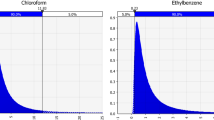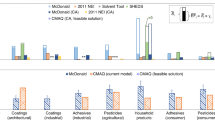Abstract
Previous studies have reported increased occurrence of respiratory and sensory irritation symptoms among residents living close to biodegradable waste sites. However, few studies have been able to quantify direct and annoyance-mediated effects based on individual-specific assessments of chemical exposures. We examined associations between residential exposures to a proxy gas (ammonia, NH3) from biodegradable wastes (mainly from farming, animal and agricultural activities) and odor annoyance and six respiratory and sensory irritation symptoms (self-reported), using adjusted logistic regression models and mediation analyses. Individual-specific NH3 exposures (n=454) in residential environments during 2005–2010 were calculated by the Danish Eulerian long-range transport model and the local-scale transport deposition model. Residential NH3 exposure was associated with increased frequency of four symptoms, including “eyes itching, dryness or irritation” and “cough” (ORadj=1.69; 95% CI: 1.09–2.61 and ORadj=1.75; 95% CI: 1.12–2.74, for each unit increase in loge(NH3 exposure)). Odor annoyance mediated the effect of exposure on cough and three sensory irritation symptoms. Mediation was either full (indirect-only effects) or partial (direct and indirect effects). This study provides support for the existence of indirect associations between residential exposures to low-to-moderate air pollution from wastes and symptoms, as well as direct dose-response associations for some of the symptoms.
This is a preview of subscription content, access via your institution
Access options
Subscribe to this journal
Receive 6 print issues and online access
$259.00 per year
only $43.17 per issue
Buy this article
- Purchase on Springer Link
- Instant access to full article PDF
Prices may be subject to local taxes which are calculated during checkout


Similar content being viewed by others
References
Schiffman SS, Walker JM, Dalton P, Lorig TS, Raymer JH, Shusterman D et al. Potential health effects of odor from animal operations, wastewater treatment, and recycling of byproducts. J Agromed 2000; 7: 7–81.
Blanes-Vidal V, Hansen MN, Adamsen APS, Feilberg A, Petersen SO, Jensen BB . Characterization of odor released during handling of swine slurry: Part I. Relationship between odorants and perceived odor concentrations. Atmos Environ 2009a; 43: 2997–3005.
Steinheider B, Both R, Winneke G . Field studies on environmental odors inducing annoyance as well as gastric and general health-related symptoms. J Psychophysiol 1998; 12: 64–79.
Sucker K, Both R, Winneke G . Review of adverse health effects of odours in field studies. Water Sci Technol 2009; 59: 1281–1289.
Linaker C, Smedley J . Respiratory illness in agricultural workers. Occup Med 2002; 52: 451–459.
Schiffman SS, Williams CM . Science of odor as a potential health issue. J Environ Qual 2005; 34: 129–138.
Herr CEW, zur Nieden A, Bödeker RH, Gieler U, Eikann TF . Ranking and frequency of somatic symptoms near composting sites with odor annoyance. Int J Hyg Environ Health 2003; 206: 61–64.
Radon K, Schulze A, Ehrenstein V, van Strien RT, Praml G, Nowak D . Environmental exposure to confined animal feeding operations and respiratory health of neighboring residents. Epidemiology 2007; 18: 300–308.
Wing S, Wolf S . Intensive livestock operations, health, and quality of life among eastern North Carolina residents. Environ Health Perspect 2000; 108: 233–238.
Wing S, Horton RA, Marshall SW, Thu K, Tajik M, Schinasi L . Air pollution and odor in communities near industrial swine operations. Environ Health Perspect 2008; 116: 1362–1368.
Aatamila M, Verkasalo PK, Korhonen MJ, Suominen AL, Hirvonen MR, Viluksela MK et al. Odour annoyance and physical symptoms among residents living near waste treatment centres. Environ Res 2011; 111: 164–170.
Claeson AS, Lidén E, Nordin M, Nordin S . The role of perceived pollution and health risk perception in annoyance and health symptoms: a population-based study of odorous air pollution. Int Arch Occup Environ Health 2013; 86: 367–374.
National Research Council, Committee on Environmental Epidemiology. Environmental Epidemiology: Use of Gray Literature and Other Data in Environmental Epidemiology vol. 2. National Research Council and National Academies Press: Washington, DC, USA. 1997.
Greenberg MI, Curtis JA, Vearrier D . The perception of odor is not a surrogate marker for chemical exposure: a review of factors influencing human odor perception. Clin Toxicol (Phila) 2013; 51: 70–76.
Blanes-Vidal V, Hansen MN, Adamsen APS, Feilberg A, Petersen SO, Jensen BB . Characterization of Odor released during handling of Swine Slurry: Part II. Effect of production type, storage and physicochemical characteristics of the slurry. Atmos Environ 2009b; 43: 3006–3014.
Shusterman D . Review of the upper airway, including olfaction, as mediator of symptoms. Environ Health Perspect 2002; 110: 649–653.
Shusterman D . Odor-associated health complaints: competing explanatory models. Chem Senses 2001; 26: 339–343.
Blanes-Vidal V, Suh H, Nadimi ES, Løfstrøm P, Ellermann T, Andersen HV et al. Residential exposure to outdoor air pollution from livestock operations and perceived annoyance among citizens. Environ Int 2012a; 40: 44–50.
Lindvall T, Radford E . Measurement of annoyance due to exposure to environmental factors. Environ Res 1973; 6: 1–36 page 3.
Dalton P Odor, annoyance and health symptoms in a residential community exposed to industrial odors. Monell Chemical Senses Center, 1997. Technical Report–TFEJ 01. Philadelphia, PA.
Blanes-Vidal V, Nadimi ES, Ellermann T, Andersen HV, Løfstrøm P . Perceived annoyance from environmental odors and association with atmospheric ammonia levels in nonurban residential communities: a cross-sectional study. Environ Health 2012b; 11: 27.
CORINAIR: Manure management regarding nitrogen compounds [http://reports.eea.europa.eu/EMEPCORINAIR5/en/B1090vs2.pdf] Accessed 24 November 2011.
Nielsen OK, Winther M, Mikkelsen MH, Hoffmann L, Nielsen M, Gyldenkærne S et al Annual Danish Informative Inventory Report to UNECE. Emission inventories from the base year of the protocols to year 2008. National Environmental Research Institute, Aarhus University: Roskilde, Denmark, 2010. NERI Technical Report No. 776, 565 pp.
Nielsen O, Winther M, Mikkelsen MH, Hoffmann L, Nielsen M, Gyldenkærne S et al Annual Danish Informative Inventory Report to UNECE. Emission inventories from the base year of the protocols to year 2010. Aarhus University, DCE – Danish Centre for Environment and Energy: Roskilde,Denmark, 2012. Scientific Report from DCE – Danish Centre for Environment and Energy No. 18, 669 pp.
Gyldenkærne S, Ambelas Skjøth C, Hertel O, Ellermann T . A dynamical ammonia emission parameterization for use in air pollution models. J Geophys Res 2005; 110: D07108.
Geels C, Brandt J, Christensen J, Frohn L, Hansen K . Long-Term Calculations with a Comprehensive Nested Hemispheric Air Pollution Transport Model, In: Faraǵo I, Georgiev K, Havasi Á (eds). Springer: Dordrecht, Netherlands. 2005 pp 185–196.
Sommer SG, Østergård HS, Løfstrøm P, Andersen HV, Jensen LS . Validation of model calculation of ammonia deposition in the neighbourhood of a poultry farm using measured NH3 concentrations and N deposition. Atmos Environ 2009; 43: 915–920.
Pul A, Hertel O, Geels C, Dore AJ, Vieno M, Jaarsveld HA et al. Modelling the atmospheric transport and deposition of ammonia at a national and regional scale. In: Sutton MA, Reis S, Baker SMH (eds). Atmospheric Ammonia: Detecting Emission Changes and Environmental Impacts. Springer. 2009, 464 pp.
Brandt J, Silver J, Frohn L. M, Geels C, Gross A, Hansen A. B et al. An integrated model study for Europe and North America using the Danish Eulerian Hemispheric Model withfocus on intercontinental transport of air pollution. Atmos Environ 2012; 53: 156–176.
Geels C, Ellermann T, Frohn L, Løfstrøm P, Christensen JH, Hertel O et al. A coupled model system (DAMOS) improves the accuracy of simulated atmospheric ammonia levels over Denmark. Biogeosciences Discussion 2012; 9: 1587–1634.
Nicell JA . Expressions to relate population responses to odor concentration. Atmos Environ 2003; 37: 4955–4964.
Baron RM, Kenny DA . The moderator-mediator variable distinction in social psychological research: conceptual, strategic, and statistical considerations. J Pers Soc Psychol 1986; 51: 1173–1182.
Sobel ME . Asymptotic intervals for indirect effects in structural equations models. In: Leinhart S (ed). Sociological Methodology. Jossey-Bass: San Francisco, CA, USA. 1982, 290–312.
MacKinnon DP, Fairchild AJ, Fritz MS . Mediation analysis. Annu Rev Psychol 2007; 58: 593.
MacKinnon DP, Dwyer JH . Estimating mediated effects in prevention studies. Eval Rev 1993; 17: 144–158.
Fangmeier A, Hadwiger-Fangmeier A, Van der Eerden L, Jager HJ . Effects of atmospheric ammonia on vegetation—a review. Environ Pollut 1994; 86: 43–82.
Krupa SV . Effects of atmospheric ammonia (NH3) on terrestrial vegetation: a review. Environ Pollut 2003; 124: 179–221.
Legge AH, Nosal M, Peake E, Strosher M, Hansen M, Lefohn AS . Air quality of an area proximal to anthropogenic emissions. In: Legge A.H, Krupa S.V (eds). Acidic Deposition: Sulphur and Nitrogen Oxides. Lewis Publishers: Chelsea, MI, USA. 1990, 249–346.
Pitcairn CER, Skiba UM, Sutton MA, Fowler D, Munro R, Kennedy V . Defining the spatial impacts of poultry farm ammonia emissions on species composition of adjacent woodland groundflora using Ellenberg Nitrogen Index, nitrous oxide and nitric oxide emissions and foliar nitrogen as marker variables. Environ Pollut 2002; 119: 9–21.
Biermann HW, Tuazon EC, Winer AM, Wallington TJ, Pitts JN, Jr . Simultaneous absolute measurements of gaseous nitrogen species in urban ambient air by long path-length infrared and ultraviolet–visible spectroscopy. Atmos Environ 1988; 22: 1545–1554.
Agency for Toxic Substances and Disease Registry (ATSDR). Toxicological Profile for Ammonia. U.S. Department of Health and Human Services, Public Health Service: Atlanta, GA, USA. 2004.
Blanes-Vidal V, Hansen MN, Pedersen S, Rom HB . Emissions of ammonia, methane and nitrous oxide from pig houses and slurry: effects of rooting material, animal activity and ventilation flow. Agric Ecosyst Environ 2008; 124: 237–244.
Schiffman SS, Studwell CE, Landerman LR, Berman K, Sundy JS . Symptomatic effects of exposure to diluted air sampled from a swine confinement atmosphere on healthy human subjects. Environ Health Perspect 2005; 113: 567–576.
Thu K, Donham K, Ziegenhorn R, Reynolds S, Thorne P, Subramanian P et al. A control study of the physical and mental health of residents living near a large-scale swine operation. J Agric Saf Health 1997; 3: 13–26.
Neutra R, Lipscomb J, Satin K, Shusterman D . Hypotheses to explain the higher symptom rates observed around hazardous waste sites. Environ Health Perspect 1991; 94: 31–38.
Taylor SM, Sider D, Hampson C, Taylor SJ, Kelly W, Walter SD et al. Community health effects of a petroleum refinery. Ecosystem Health 1997; 3: 28–43.
Fiedler K, Schott M, Meiser T . What mediation analysis can (not) do. J Exp Soc Psychol 2011; 47: 1231–1236.
Heavner K, Phillips CV, Burstyn I, Hare W . Dichotomization: 2 × 2 ( × 2 × 2 × 2 …) categories: infinite possibilities. BMC Med Res Methodol 2010; 10: 59.
MacCallum RC, Zhang S, Preacher KJ, Rucker DD . On the practice of dichotomization of quantitative variables. Psychol Methods 2002; 7: 19–40.
MacKinnon DP . Introduction to Statistical Mediation Analysis. Erlbaum: Mahwah, NJ, USA. 2007.
Dalton P . Odor perception and beliefs about risk. Chem Senses 1996; 21: 447–458.
Acknowledgements
This study was supported by the Department of Chemical Engineering, Biotechnology and Environmental Technology, University of Southern Denmark, Odense, Denmark.
Author information
Authors and Affiliations
Corresponding author
Ethics declarations
Competing interests
The authors declare no conflict of interest.
Additional information
Supplementary Information accompanies the paper on the Journal of Exposure Science and Environmental Epidemiology website
Supplementary information
Rights and permissions
About this article
Cite this article
Blanes-Vidal, V., Bælum, J., Schwartz, J. et al. Respiratory and sensory irritation symptoms among residents exposed to low-to-moderate air pollution from biodegradable wastes. J Expo Sci Environ Epidemiol 24, 388–397 (2014). https://doi.org/10.1038/jes.2014.20
Received:
Accepted:
Published:
Issue Date:
DOI: https://doi.org/10.1038/jes.2014.20
Keywords
This article is cited by
-
Self-reported data in environmental health studies: mail vs. web-based surveys
BMC Medical Research Methodology (2019)
-
Living in the Clean, Stress-Free and Quiet Countryside: Does the Reality Match the Dream? Residential Exposure to Environmental Health Stressors in the Danish Countryside
Human Ecology (2017)



